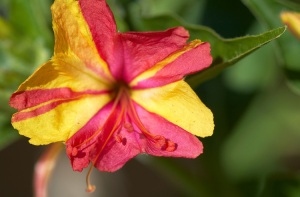Marvel of Peru
Mirabilis jalapa
Botanical Name: Mirabilis jalapa meer-AB-ill-iss jah-LAH-pah![]() Common Name: Four o’clocks, Marvel of Peru Genus: Mirabilis
Common Name: Four o’clocks, Marvel of Peru Genus: Mirabilis
This bushy perennial has oval, deep green leaves on branched stems. In summer, blooms appear: fragrant red, pink, magenta, yellow or white flowers with a delicate, faded-vanilla aroma. Flowers open in late afternoon and die by morning.
Care: Grow in moderately fertile, well-drained soil. Protect with a mulch or lift tubers in winter where marginally hardy. Protect from excessive winter moisture.
Propagation: Divide tubers in spring.
Problems: White rust, brown rust, and leaf spot.
| Common Name | Marvel Of Peru |
| Family | Nyctaginaceae |
| Synonyms | |
| Known Hazards |  The seeds and the rots are reported to cause digestive disturbances[274]. The seeds and the rots are reported to cause digestive disturbances[274]. |
| Habitats | Not known |
| Range | S. America – Peru. Naturalized in France and possibly other places in Europe. |
| Edibility Rating |   |
| Medicinal Rating |   |
| Care | |
Summary Physical Characteristics

Mirabilis jalapa is a PERENNIAL growing to 0.6 m (2ft) by 0.5 m (1ft 8in). It is hardy to zone 8 and is frost tender. It is in flower from Jul to October, and the seeds ripen from Aug to October. The flowers are hermaphrodite (have both male and female organs) and are pollinated by Insects.
Suitable for: light (sandy), medium (loamy) and heavy (clay) soils and prefers well-drained soil. Suitable pH: acid, neutral and basic (alkaline) soils. It can grow in semi-shade (light woodland) or no shade. It prefers moist soil.
Habitats Cultivated Beds;Edible Uses Edible Parts: Leaves.
Edible Uses: Colouring; Condiment.Tender young leaves – cooked as a vegetable[105, 183, 272]. An emergency food, only eaten when all else fails[177]. An edible crimson dye is obtained from the flowers[46, 61, 105, 177]. It is used for colouring cakes and jellies[183]. The seed is crushed and used as a pepper substitute[105, 177, 183].Medicinal Uses
Plants For A Future can not take any responsibility for any adverse effects from the use of plants. Always seek advice from a professional before using a plant medicinally.Diuretic; Purgative; Vulnerary.
The root is aphrodisiac, diuretic and purgative. It is used in the treatment of dropsy[46, 61, 154, 218, 240]. A paste of the root is applied as a poultice to treat scabies and muscular swellings[272]. The juice of the root is used in the treatment of diarrhoea, indigestion and fevers[272]. The powdered root, mixed with corn flour (Zea mays) is baked and used in the treatment of menstrual disorders[272]. The leaves are diuretic[272]. They are used to reduce inflammation[240]. A decoction of them is used to treat abscesses[218]. The leaf juice is used to treat wounds[218].
Other UsesCosmetic; Dye.The powdered seed is used as a cosmetic[46, 61].
Cultivation details Succeeds in almost any ordinary garden soil[1]. Prefers a fertile well-drained soil in full sun or part day shade[200]. This species is not very hardy in Britain. The top growth is cut back by frost but the tuber survives the winter outdoors if the temperature does not fall much below -5°c, a good mulch would be beneficial[200]. Tubers can be lifted and stored over winter in a cool frost free place in the same way that dahlia tubers are stored[1, 200]. The marvel of Peru is usually grown as a half-hardy annual in temperate zones, it flowers freely in its first year[200]. Plants also self-sow freely in warmer areas (these seedlings can be easily transplanted) and they can become a weed in such situations due to their deep rooting habit[200]. This species was cultivated as a medicinal plant by the Aztecs prior to the Spanish conqust[274]. The flowers are sweetly scented and do not open until the afternoon[233]. The young growth is particularly susceptible to aphis infestation[200]. Members of this genus are rarely if ever troubled by browsing deer[233].
Propagation Seed – sow spring in a greenhouse. When they are large enough to handle, prick the seedlings out into individual pots and plant them out in early summer, after the last expected frosts. The seed remains viable for several years[196]. Division in spring as the plant comes into growth[200].







btw i just found a nice patch of deep purple wild violets by old rotted tree in woods on walk, am taking a clump tomorrow heehee, took pics will post later
April 26, 2013 at 4:01 pm
great 😀 im focusing on the practical side so we cover 360o of the whole angle 🙂
April 26, 2013 at 4:04 pm
good because i am addicted to flowers as you can see lol
April 26, 2013 at 4:06 pm
oh me too but thanx to the austerity im focusing more on what-were-gonna-eat-today lmao 😉
April 26, 2013 at 4:11 pm
Do you know where I can get seeds of the Blue variety
October 13, 2017 at 10:57 pm
https://davesgarden.com/guides/pf/go/92/
November 12, 2017 at 8:50 am